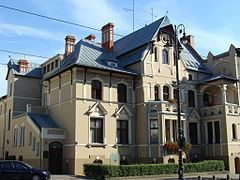Type Villa Completed 1898 Floors 3 Architect Heinrich Seeling | Country Poland Opened 1898 Construction started 1897 | |
 | ||
Architectural style Eclecticism & Neo-Gothic Classification N°601301-Reg.A/1128/1-4, July 7, 1992 and September 29, 1998. Location Gdańska Street 48, Bydgoszcz, Poland Similar Villa Wilhelm Blumwe i, Villa Fritz Heroldt in Bydgoszcz, Mix Ernst tenement in Bydgos, Villa Carl Grosse in Bydgoszcz, Hugo Hecht tenement | ||
The Villa Heinrich Dietz is a historical house in downtown Bydgoszcz, also called "Villa Flora".
Contents
Location
The building stands on eastern side of Gdańska Street at N°48, between Śniadecki street and Słowacki street.
History
The villa was built in 1897-1898, from a design by design Berlin architect Heinrich Seeling. Initial address was "Villa Dietz, Danzigerstrasse 146, Bromberg". The owner of the villa, Heinrich Dietz, was a rentier, member of the city council and member of the Prussian parliament. He was the co-founder of the inland navigation company Lloyd which had its seat located downtown, by the riverside. The house remained in the hands of his heirs until 1937.
During the Nazi occupation (1940-1945), the building was the seat of SS municipal headquarters. After 1945, it has been handed over to Pomerania and Kujawy Polish Radio. Afterwards, the villa has been linked by a covered walkway to the adjacent house, the Villa Wilhelm Blumwe.
In 1995, the renovation of the building was rewarded: Pomerania and Kujawy Polish Radio received a price by the National Heritage Funds in a competition for the best historical object organized.
Architecture
The villa has been built in the eclectic style, with Neo-Gothic elements and Neo-Renaissance. Perhaps this style was also inspired by the architecture of picturesque English influences. The footprint of the building is irregular but rather close to a rectangle. The outside appearance of the villa is highly fragmented, with various avant-corps, balconies and loggias.
Over the main front elevation (on to Gdańska Street) stands a three-story avant-corps with a balcony, set beneath the gable and the pediment. The second avant-corps located on the northern side has an indoor loggia covered by a lean-to roof. Bricked railings are decorated with a stylized trefoil shapes. In facade decoration are also used volutes and obelisk-shaped pinnacles.
The name Villa Flora is related to murals adorning of the gone loggia.
The interior of the building is adorned with painted friezes - birds and flowers. Also survived until today a magnificent woodwork and panelling, the ceiling with gold decorations, all made in papier-mâché technique. The backyard (eastern side of the building) is adjacent to a small garden associated with Villa Wilhelm Blumwe, where stands an original 19th-century fountain decorated with polychrome sculpture of herons.
The building has been put on the Pomeranian heritage list (N°601301-Reg.A/1128/1-4) on the 07th July 1992 and 29 September 1998.
